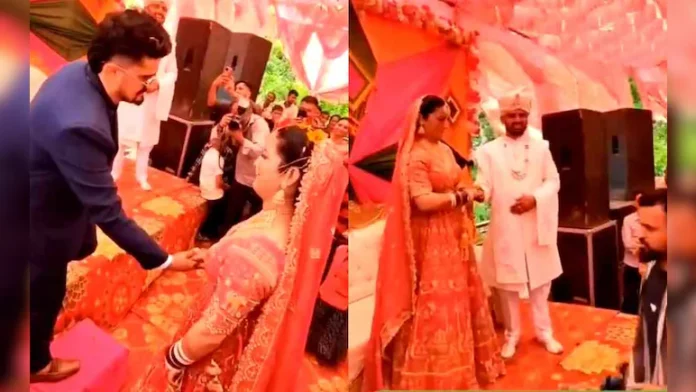
A woman in Shillai village, Himachal Pradesh, India married two brothers in a rare polyandrous ceremony, locally known as Jodidara.
The wedding, held in the Trans-Giri area of Sirmaur district, began on July 12, 2025 and was filled with local folk songs, traditional dances, and cultural rituals.
The three-day ceremony drew hundreds of people from far and near.
Bride Sunita Chauhan and grooms, Pradeep and Kapil Negi said the marriage was a mutual decision taken without any external pressure.
Photos and videos of the ceremony have gone viral on social media, sparking renewed discussion on the tribal practice, legally recognised under Himachal Pradesh’s revenue laws as “Jodidara”.
In Badhana village alone, five such polyandrous weddings have taken place in the last six years.
Sunita, a native of Kunhat village, said she was aware of the tradition before entering the marriage.
“I made my decision without any pressure. I respect the bond we have formed, she said.
Pradeep, who works in a government department, hails from Shillai. His younger brother Kapil has a job abroad.
“We followed the tradition publicly as we are proud of it and it was a joint decision,” said Pradeep.
Kapil added, “We may live apart, but through this marriage, we’re ensuring support, stability and love for our wife as a united family. We’ve always believed in transparency,” he said.
According to the Times of India, the Hatti community, which resides along the Himachal-Uttarakhand border, was declared a Scheduled Tribe three years ago.
Polyandry has long been part of its tradition, although it has become increasingly rare with growing literacy and economic development in the region.
While such marriages still take place, elders say many are now solemnised discreetly, though society continues to accept them.
Experts attribute the origin of the practice to the need to preserve family land holdings.
Division of ancestral land among siblings was avoided through polyandry, while the share of tribal women in property remains a contentious issue in many areas.
Around three lakh members of the Hatti tribe live across nearly 450 villages in the Trans-Giri belt of Sirmaur. Though declining, polyandry is still practiced in select areas.
Similar traditions were historically observed in Jaunsar Babar in Uttarakhand and the Kinnaur district of Himachal Pradesh.
Kundan Singh Shastri, general secretary of the Kendriya Hatti Samiti — the apex body representing the community — said the practice originated thousands of years ago.
“This tradition was invented to save a family’s agricultural land from further division,” he said.
Another reason, he explained, was to strengthen brotherhood and foster unity in joint families by allowing even half-brothers to marry the same woman.
“The third reason is a feeling of security. If you have a bigger family, more men, you are more secure in a tribal society,” Shastri said, adding it also helped in cultivating and managing scattered farmlands in remote hilly areas.
“These requirements of tribal families have kept the polyandry system for thousands of years in practice, though these traditions are slowly dying,” he added.
In this unique tradition, known locally as “Jajda”, the bride is brought to the groom’s village in a procession.
At the groom’s residence, a ritual called “Seenj” is performed. A priest chants mantras in the local dialect, sprinkles holy water on the couple, and offers jaggery — a symbolic gesture for sweetness and harmony in their married life, invoking blessings from the family deity, or Kul Devta.






